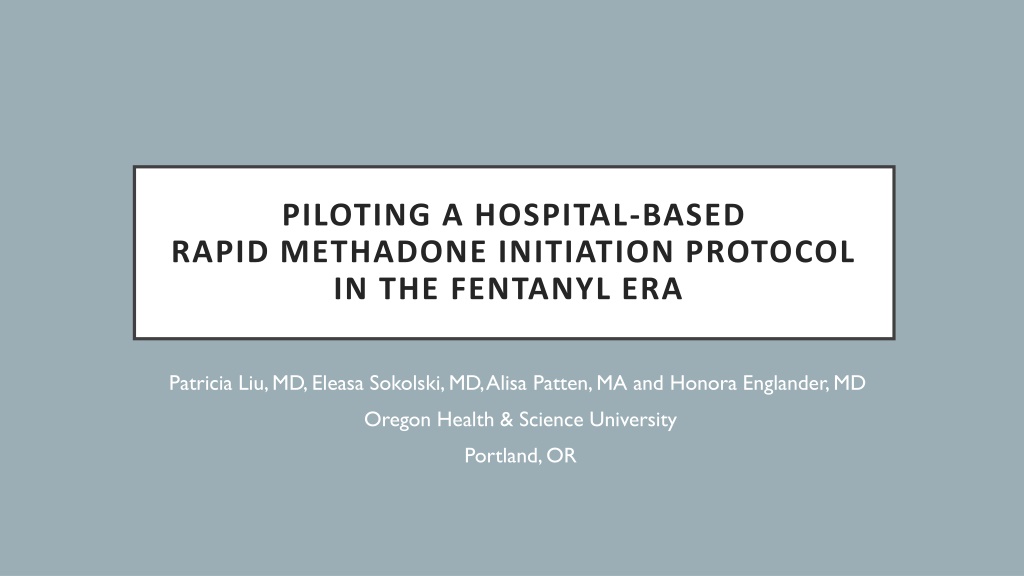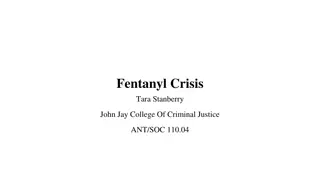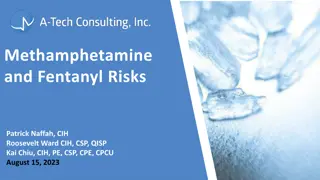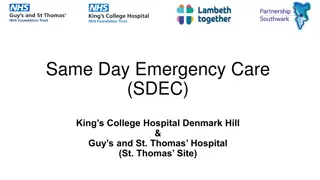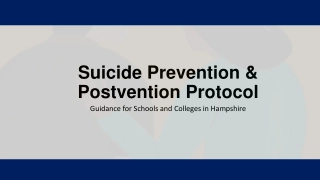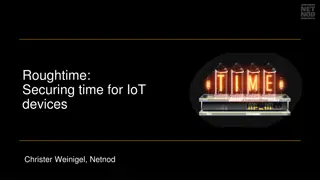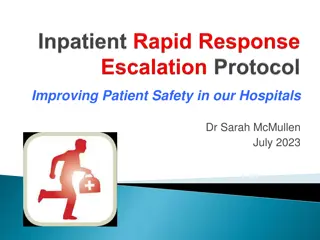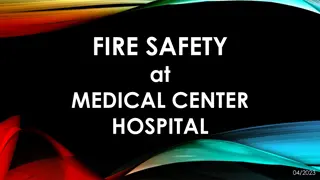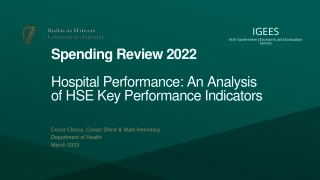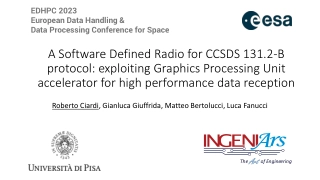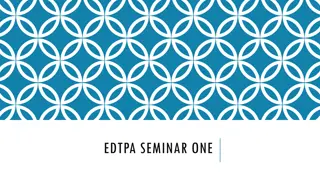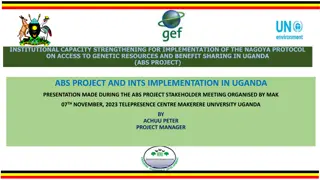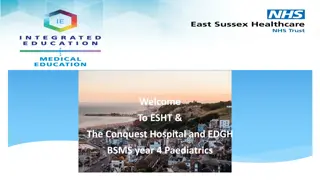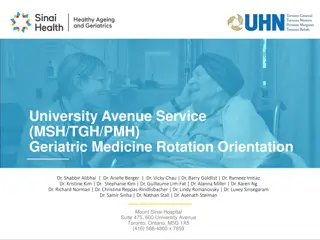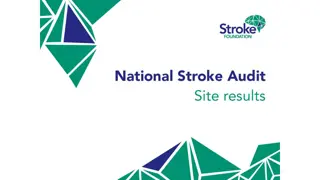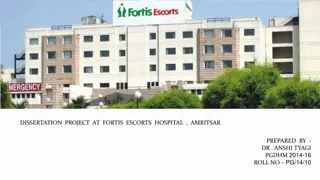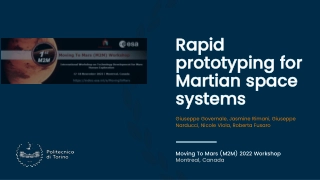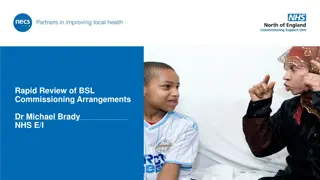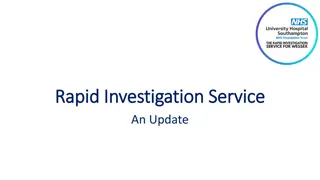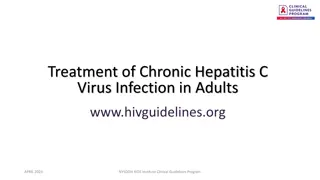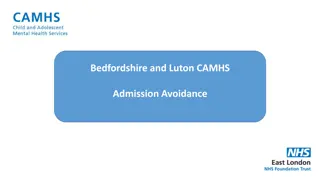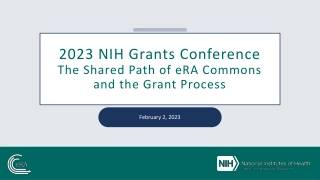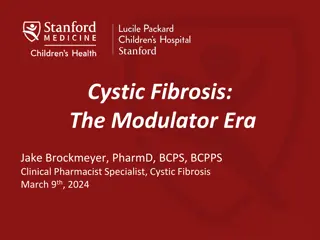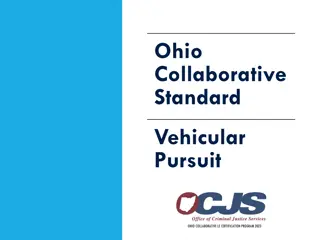Hospital-Based Rapid Methadone Initiation Protocol in Fentanyl Era
The study explores the implementation of a rapid methadone initiation protocol in a hospital setting to address the challenges posed by fentanyl in opioid use disorder treatment. The team's experience over nine months following the protocol's introduction is detailed, highlighting the importance of timely interventions and close patient monitoring during hospitalization for effective treatment.
Download Presentation
Please find below an Image/Link to download the presentation.
The content on the website is provided AS IS for your information and personal use only. It may not be sold, licensed, or shared on other websites without obtaining consent from the author. Download presentation by click this link. If you encounter any issues during the download, it is possible that the publisher has removed the file from their server.
Presentation Transcript
PILOTING A HOSPITAL-BASED RAPID METHADONE INITIATION PROTOCOL IN THE FENTANYL ERA Patricia Liu, MD, Eleasa Sokolski, MD, Alisa Patten, MA and Honora Englander, MD Oregon Health & Science University Portland, OR
DISCLOSURES No disclosures
BACKGROUND The introduction of illicitly manufactured fentanyl has made the drug supply deadlier and has complicated the way patients and providers approach OUD treatment1 Higher opioid tolerance has caused traditional therapeutic doses of medications for opioid use disorder to be insufficient2,3 Methadone initiation schedules in the OTP settings are still conservative and can result in weeks of titration to achieve effective doses4 1: Adhmed et al. National Center for Health Statistics. 2023 2: Silverstein, SM et al. Int J Drug Policy, 2019 3: Buresh, M et al. J Subst Abuse Treat, 2022 4: Bromley, L et al. Meta: Phi, 2021
BACKGROUND Trends in hospitalization related to opioid use have been significantly increasing5 Hospitalization provides a unique opportunity for a reachable moment to engage with patients and begin treatment6 Hospitalization is also an opportunity to closely monitor patients to potentially shorten the methadone titration period 5: Ronan et al. Health Affairs. 2016 6: Weinstein et al . Treating Opioid Use Disorder in General Medical Settings. 2021
RACIAL INEQUALITIES IN HOSPITAL CARE Studies have found a negative relationship between the availability of hospital-based OUD programs and the racial make up of the surrounding community8 After an ED-visit or hospitalization, black and Hispanic patients received MOUD less frequently than white patients9 8: Change et al. J Subst Abuse Treat. 2022 9: Barnett et al. N Engl J Med. 2023 Invoca.com
TRADITIONAL INITIATION RECOMMENDATIONS Snyder., H., et al. Methadone Quick Start. CA Bridge 2023
OBJECTIVES Our interprofessional addiction medicine consult service, the Improving Addiction Care Team (IMPACT), developed a rapid methadone initiation protocol We describe our experience with the first 9 months following protocol implementation.
METHODS: RAPID METHADONE PROTOCOL Eligibility Criteria Routine non-prescribed fentanyl use IMPACT consult
METHODS: RAPID METHADONE PROTOCOL Clinical Contraindications End organ failure such as pulmonary disease, cirrhosis, ESRD, heart failure Ventricular arrhythmia, QTc>500 Concurrent use of benzodiazepines, alcohol Medications that may affect methadone metabolism Age >65
METHODS: RAPID METHADONE PROTOCOL Day Max TDD Methadone 60mg Recommended Dosing 1 30 or 40mg x1 + 10mg q3hrs PRN x 2 or 3 doses 50mg x1 + 10mg q3hrs PRN x 2 doses 60mg x1 + 10mg q3hrs PRN x 2 doses 70mg (or average of TDD from prior days) x1 10 mg q3h PRN x 3 doses 2 70mg 3 80mg 4-7 100mg *We allowed patients to receive full opioid agonists during rapid methadone initiation
METHODS Design/setting: Registry study of hospitalized patients who received the rapid methadone protocol at a single academic center Participants: Patients seen by IMPACT with OUD who received the rapid methadone protocol Patients were excluded if they received methadone maintenance from OTP within 7 days of admission or less than 3 doses of methadone during admission Data source: We abstracted patient characteristics from the electronic health record. Manual chart review was performed for methadone daily dose, adverse events attributable to methadone and MME s of other opioid agonists received Outcomes: Primary outcome was daily methadone dose received. Secondary outcomes included safety events attributable to methadone, daily MME s of other opioid agonists received
Unique Individuals Age (mean SD) Female (n, %) Admission Diagnosis Type (n, %) Obstetrics Infection Trauma Vascular Houseless Active Fentanyl use Substance Use History (n, %) Opioid use disorder Methamphetamine use disorder Alcohol use disorder Benzodiazepine use disorder MOUD history (n, %) Prior methadone Prior buprenorphine LOS, days (mean SD) Patient directed discharge 25 37.5 11.2 9 (36%) RESULTS: PATIENT CHARACTERISTICS 3 (12%) 17 (68%) 4 (16%) 1 (4%) 16 (64%) 25 (100%) 25 (100.0%) 14 (56%) 0 (0%) 2 (8%) 20 (80%) 12 (48%) 13.7 10.5 3 (12%)
RESULTS: METHADONE DOSES RECEIVED IMPACT Consulted 97mg 92mg 87mg 80mg 75mg 69mg 53mg 39mg
RESULTS: METHADONE DOSES RECEIVED IMPACT Consulted 97mg 92mg 87mg 80mg 75mg 69mg 53mg 39mg = Expected dose of methadone received based on traditional inpatient schedules
RESULTS: ADVERSE EVENTS No patients experienced adverse events requiring holding a dose of scheduled methadone, naloxone administration or transfer to higher level of care
RESULTS: OTHER FULL OPIOID AGONISTS Day of IMPACT Consult Patients who received methadone Average MME of other full opioid agonists 71.4 72.0 118.6 122.1 160.2 190.3 219.2 324.4 195.5 273.7 155.4 123.0 154.8 56.8 82.8 82.7 Average TDD methadone (mg) -1 1 2 3 4 5 6 7 39.1 14.5 53.0 12.9 69.2 11.2 75.4 14.5 79.5 15.6 87.1 13.6 92.2 14.9 96.6 16.6 11 25 25 23 21 17 16 16
DISCUSSION We introduced a hospital based rapid methadone initiation protocol with strict inclusion and exclusion criteria Patients reached a therapeutic dose of methadone more quickly with the rapid methadone protocol than traditional dosing schedules We observed no adverse events attributable to methadone Short acting full opioid agonists, in addition to methadone, were used to treat withdrawal and pain in nearly all patients in our cohort but the amounts and duration varied.
IMPLICATIONS As we develop and evaluate new methadone dosing schedules, emphasis should be made on appropriate patient selection in order to mitigate risk. Our study highlights the importance of using short acting opioid agonists to treat pain and withdrawal while up-titrating methadone in the hospital. The literature suggests that by more effectively treating patients withdrawals, cravings and pain, we can improve the likelihood of patients staying in the hospital to complete their recommended treatment course10, 11 10: Alrawashdeh, M., et al. J Gen Intern Med. 2023 11: Ti L et al. Am J public Health. 2015
LIMITATIONS Limitations include small sample size and lack of matched controls We did not follow patients long term/after discharge, specifically to continue monitoring for adverse events We also did not assess the qualitative patient experience
CONCLUSION Rapid methadone initiation protocol for hospitalized patients with OUD is feasible and patients reached a therapeutic dose of methadone more quickly than with traditional methods This provides another tool for clinicians to respond to the unprecedented opioid tolerances seen in the fentanyl era Appropriate patient selection may be crucial to avoid adverse events
REFERENCES 1. Ahmad, F., J. Cisewski, L. Rossen, and P. Sutton. Provisional drug overdose death counts. US Department of Health and Human Services, CDC, National Center for Health Statistics 2023 [cited 2023 September 11]; Available from: https://www.cdc.gov/nchs/nvss/vsrr/drug- overdose-data.htm. 2. Silverstein, S.M., et al., "Everything is not right anymore": Buprenorphine experiences in an era of illicit fentanyl. Int J Drug Policy, 2019. 74: p. 76-83. 3. Buresh, M., S. Nahvi, S. Steiger, and Z.M. Weinstein, Adapting methadone inductions to the fentanyl era. J Subst Abuse Treat, 2022. 141: p. 108832. 4. Bromley, L., et al. Methadone treatment for people who use fentanyl: Recommendations. . META:PHI 2021 [cited 2023 September 14]; Available from: https://www.metaphi.ca/wp-content/uploads/Guide_MethadoneForFentanyl.pdf. 5. Ronan MV, Herzig SJ. Hospitalizations Related To Opioid Abuse/Dependence And Associated Serious Infections Increased Sharply, 2002-12. Health Aff (Millwood). 2016 May 1;35(5):832-7. doi: 10.1377/hlthaff.2015.1424. PMID: 27140989; PMCID: PMC5240777. 6. Weinstein, Z.M., Englander, H. (2021). Reachable Moment: Hospital-Based Interventions. In: Wakeman, S.E., Rich, J.D. (eds) Treating Opioid Use Disorder in General Medical Settings. Springer, Cham. https://doi.org/10.1007/978-3-030-80818-1_4 7. Snyder., H., et al. Methadone Quick Start. CA Bridge 2023 [cited 2023 September 19]; Available from: https://bridgetotreatment.org/resource/methadone-hospital-quick-start/. 8. Chang JE, Franz B, Cronin CE, Lindenfeld Z, Lai AY, Pag n JA. Racial/ethnic disparities in the availability of hospital based opioid use disorder treatment. J Subst Abuse Treat. 2022 Jul;138:108719. doi: 10.1016/j.jsat.2022.108719. Epub 2022 Feb 1. PMID: 35125254. 9. Barnett ML, Meara E, Lewinson T, Hardy B, Chyn D, Onsando M, Huskamp HA, Mehrotra A, Morden NE. Racial Inequality in Receipt of Medications for Opioid Use Disorder. N Engl J Med. 2023 May 11;388(19):1779-1789. doi: 10.1056/NEJMsa2212412. PMID: 37163624; PMCID: PMC10243223. 10. Alrawashdeh, M., et al., Association of Early Opioid Withdrawal Treatment Strategy and Patient-Directed Discharge Among Hospitalized Patients with Opioid Use Disorder. J Gen Intern Med, 2023. 38(10): p. 2289-2297. 11. Ti L, Ti L. Leaving the Hospital Against Medical Advice Among People Who Use Illicit Drugs: A Systematic Review. Am J Public Health. 2015 Dec;105(12):e53-9. doi: 10.2105/AJPH.2015.302885. Epub 2015 Oct 15. PMID: 26469651; PMCID: PMC4638247.
